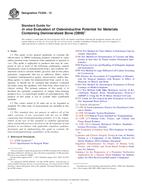We need your consent to use the individual data so that you can see information about your interests, among other things. Click "OK" to give your consent.
ASTM F2459-12
Standard Test Method for Extracting Residue from Metallic Medical Components and Quantifying via Gravimetric Analysis
STANDARD published on 1.3.2012
The information about the standard:
Designation standards: ASTM F2459-12
Note: WITHDRAWN
Publication date standards: 1.3.2012
SKU: NS-53920
The number of pages: 7
Approximate weight : 21 g (0.05 lbs)
Country: American technical standard
Category: Technical standards ASTM
The category - similar standards:
Annotation of standard text ASTM F2459-12 :
Keywords:
extractable residue, gravimetric analysis, metallic medical components, non-soluble extractables, non-soluble debris, water soluble extractables, Gravimetric determination, Medical devices/equipment, Quantitative analysis/measurement, Residue, Water-soluble extractable residue, ICS Number Code 11.100.99 (Other standards related to laboratory medicine)
Additional information
| Significance and Use | ||||||||||
|
This test method is suitable for determination of the extractable residue in metallic medical components. Extractable residue includes aqueous and non-aqueous residue, as well as non-soluble residue. This test method recommends the use of a sonication technique to extract residue from the medical component. Other techniques, such as solvent reflux extraction, could be used but have been shown to be less efficient in some tests, as discussed in X1.2. This test method is not applicable for evaluating the extractable residue for the reuse of a single-use component (SUD). |
||||||||||
| 1. Scope | ||||||||||
|
1.1 This test method covers the quantitative assessment of the amount of residue obtained from metallic medical components when extracted with aqueous or organic solvents. 1.2 This test method does not advocate an acceptable level of cleanliness. It identifies one technique to quantify extractable residue on metallic medical components. In addition, it is recognized that this test method may not be the only method to determine and quantify extractables. 1.3 Although these methods may give the investigator a means to compare the relative levels of component cleanliness, it is recognized that some forms of component residue may not be accounted for by these methods. 1.4 The applicability of these general gravimetric methods have been demonstrated by many literature reports; however, the specific suitability for applications to all-metal medical components will be validated by an Interlaboratory Study (ILS) conducted according to Practice E691. 1.5 This test method is not intended to evaluate the residue level in medical components that have been cleaned for reuse. This test method is also not intended to extract residue for use in biocompatibility testing. Note 1—For extraction of samples intended for the biological evaluation of devices or materials, refer to ISO 10993–12. 1.6 The values stated in SI units are to be regarded as standard. No other units of measurement are included in this standard. 1.7 This standard may involve hazardous or environmentally-restricted materials, operations, and equipment. This standard does not purport to address all of the safety concerns, if any, associated with its use. It is the responsibility of the user of this standard to establish appropriate safety and health practices and determine the applicability of regulatory limitations prior to use. |
||||||||||
| 2. Referenced Documents | ||||||||||
|
Similar standards:
Historical
1.2.2013
Historical
15.10.2010
Historical
1.12.2011
Historical
1.4.2012
Historical
1.3.2011
Historical
1.3.2014
We recommend:
Technical standards updating
Do you want to make sure you use only the valid technical standards?
We can offer you a solution which will provide you a monthly overview concerning the updating of standards which you use.
Would you like to know more? Look at this page.



 ASTM F2529-13
ASTM F2529-13 ASTM F2808-10
ASTM F2808-10 ASTM F2883-11
ASTM F2883-11 ASTM F2884-12
ASTM F2884-12 ASTM F2903-11
ASTM F2903-11 ASTM F2952-14
ASTM F2952-14
 Cookies
Cookies
